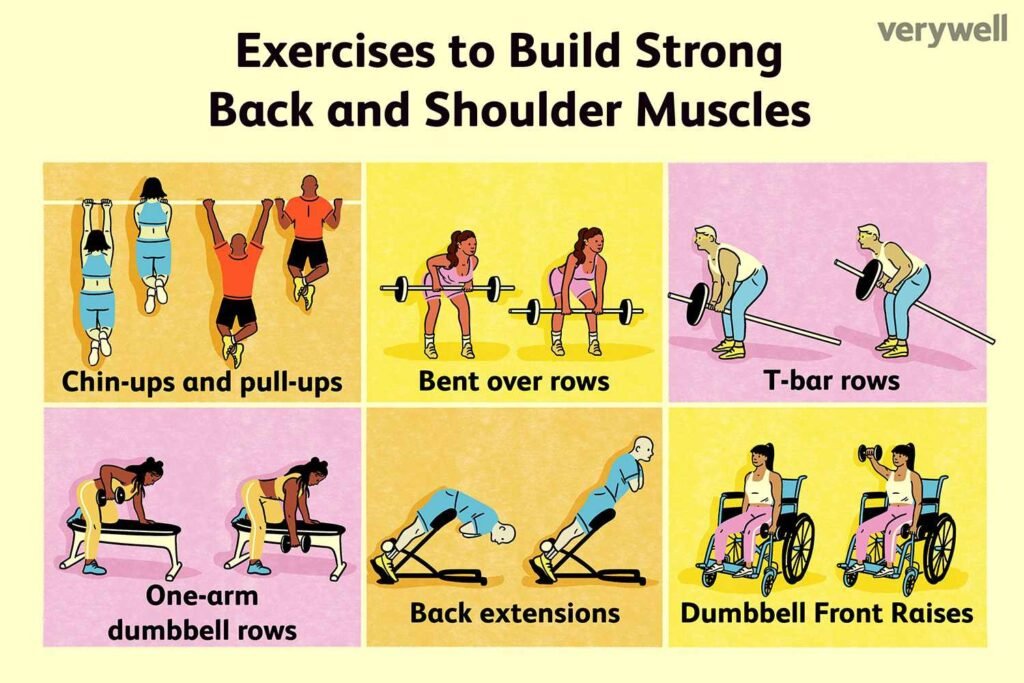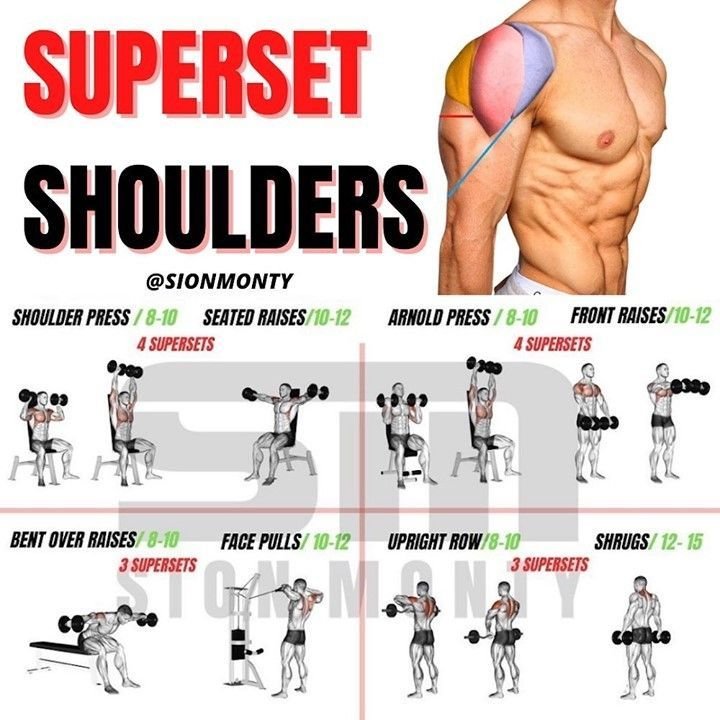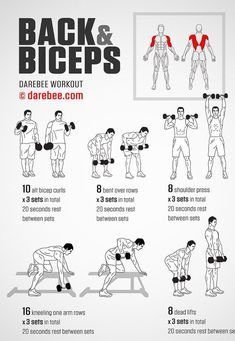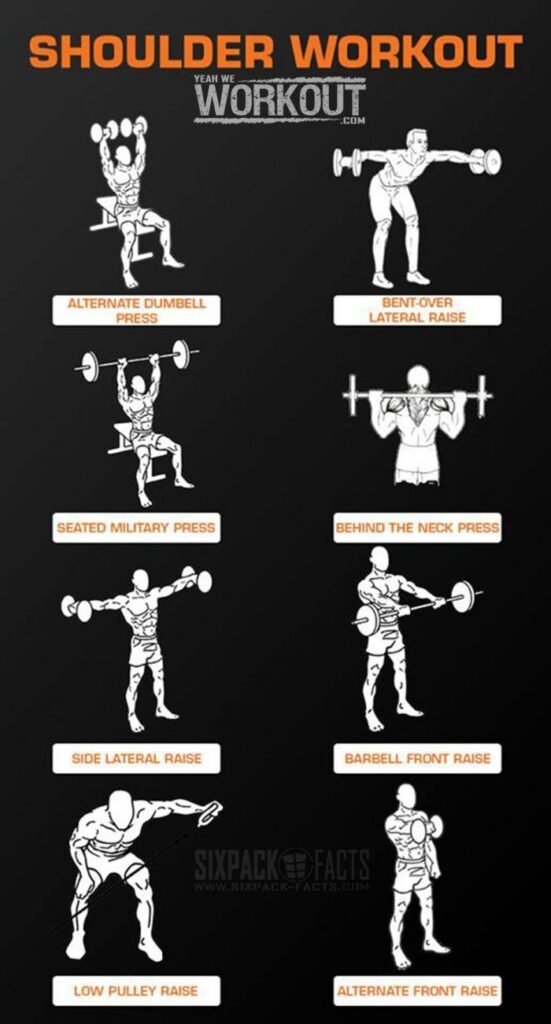Imagine walking into the gym, filled with energy and the sound of weights clanging. You see people with different fitness goals. Some want toned arms, others a strong back. You think about your fitness journey, the late nights and doubts, and how you’ve changed.

This journey is about more than looks. It’s about strength, endurance, and feeling good in your own skin. You’re ready to improve your upper body strength. A good back, shoulders, and biceps workout is key for a balanced physique and everyday activities.
We’ll explore effective workouts and essential exercises for back shoulders biceps. Whether you’re new or experienced, get ready to take your fitness to the next level!
Table of Contents
Introduction to Back, Shoulders & Biceps Training
Training the back, shoulders, and biceps together is a great way to build upper body strength. It makes you look better and boosts your fitness. Working out these muscles together increases muscle size, improves posture, and makes you more stable.
Good workouts last 30 to 45 minutes. They include supersets, which are important, with about four in each session. You usually do 10-12 reps per exercise and warm up with 10-15 reps.
Having the right gear is key for effective back shoulders biceps training. You’ll need dumbbells, a barbell, a chair, a bench or ball, and a resistance band. These tools let you do different exercises and suit various fitness levels, from beginners to experts.
| Exercise | Sets | Repetitions | Rest Time |
|---|---|---|---|
| Bent-Over Dumbbell Row | 3 | 8-12 | 60-90 seconds |
| Close-Grip Lat Pulldown | 3 | 8-12 | 60-90 seconds |
| Machine Reverse Flye | 3 | 8-12 | 1 minute |
| Alternating Dumbbell Curl | 3 | 10-20 (per arm) | 45-60 seconds |
| Chest-Supported Row | 3 | 8-12 | 60-90 seconds |
| Wide-Grip Pulldown | 3 | 8-12 | 60-90 seconds |
| Single-Arm Dumbbell Row | 3 | 8-12 | 1 minute |
| Cable Rear Delt Flye | 3 | 10-15 | No rest between arms, 1 minute between sets |
Using a well-thought-out routine with these exercises helps develop your upper body evenly. This approach improves muscle function, boosts performance, and enhances your look over time.
Benefits of Combining Back and Biceps Workouts
Working out your back and biceps together has many benefits. It makes your workouts more efficient and helps you see better results. The benefits of back and biceps workouts go beyond saving time. They also boost strength and help muscles recover faster.
Efficient Training Sessions
One big plus of this method is making your workouts more efficient. Exercises like one-arm dumbbell rows work both your back and biceps at once. This way, you hit two muscle groups in one go, saving time and improving overall performance.
Maximizing Recovery for Muscle Growth
Working out your back and biceps together also helps with recovery. It lets your muscles rest better, reducing the risk of injury. For example, you can do strength training two or more times a week. You could focus on arms and shoulders one day and back and biceps the next. This approach helps you target specific muscles and keeps them healthy.
For those interested in the benefits of back and biceps workouts, understanding their connection is key. By focusing on muscle synergy, you can improve muscle growth and overall health.
| Workout Type | Benefits | Recovery Time |
|---|---|---|
| Back & Biceps Combined | Increased efficiency, improved muscle engagement | More effective rest between sessions |
| Split Training (e.g., Push/Pull/Legs) | Focused workouts, targeted gains | Less fatigue per session |
| Full Body Workouts | Diverse exercises, varied muscle engagement | Requires longer recovery due to higher fatigue |

Understanding Your Muscle Groups
Knowing how your muscles work is key to a good workout plan. It helps you reach your fitness goals. Back muscles are crucial for strength and keeping your posture right. Biceps help with lifting and improve your performance in many activities.
The Importance of Back Muscles
The back has important muscles like the latissimus dorsi, trapezius, and erector spinae. The latissimus dorsi helps with pulling and lifting. The trapezius has three parts that help with moving and stabilizing your shoulders.
The erector spinae keeps your spine stable and helps keep you upright during exercises.
Why Biceps Matter in Strength Training
The biceps play a big part in strength training. They have two main parts: the short and long heads. A strong bicep helps with pulling, like in chin-ups or curls.
The brachialis is also key for bigger biceps. Using your forearm muscles, like in Hammer Curls, makes strength exercises more effective.
| Muscle Group | Function | Key Exercises |
|---|---|---|
| Back Muscles | Supports posture and lifting | Pull-Ups, Rows, Deadlifts |
| Biceps | Facilitates pulling movements | Bicep Curls, Chin-Ups, Hammer Curls |
Creating the Ultimate Workout Plan
Creating a good workout plan for back shoulders biceps can lead to great strength and muscle growth. Using a push/pull/legs split makes workouts efficient. It focuses on specific muscle groups and allows for enough recovery time.
Structure Your Workout: Push/Pull/Legs Split
The push/pull/legs split is a structured way to train. It divides workouts into three parts. Each muscle group gets the focus it needs without overworking.
- Push Day: Focus on exercises that target the chest, shoulders, and triceps.
- Pull Day: Concentrate on back and biceps movements, maximizing development of the latissimus dorsi and biceps brachii.
- Leg Day: Engage the lower body for overall strength and stability.
This method ensures a balanced workout plan for back shoulders biceps. It makes sure each session is intense and targets the right muscles. Using the shoulders and biceps together on pull day can include supersets. This helps muscle growth by pairing exercises wisely.
Workout Frequency Recommendations
Choosing the right workout frequency is key for the best results. Studies suggest doing at least 10 sets per week for muscles like back and biceps. This helps build muscle well.
| Training Level | Recommended Sets per Week | Focus |
|---|---|---|
| Beginners | 10-15 Sets | Intensity and Form |
| Intermediate | 15-20 Sets | Progressive Overload |
| Advanced | 20+ Sets | Training Volume and Focus |
Following these set recommendations helps with muscle growth. It keeps you focused and maintains proper form. The push/pull/legs split lets you adjust based on your fitness goals. This ensures you keep making progress.
Essential Exercises for Back Strength
Adding back strength exercises to your workout is key for a complete fitness plan. Exercises like pull-ups and lat pulldowns help build back muscles. They also improve posture and stability. These exercises focus on different areas to help with muscle growth and better performance.
Pull-Ups and Lat Pulldowns
Pull-ups are a top exercise for building back strength. They work the lats, rhomboids, and traps. To do a pull-up, grip the bar with palms facing away and pull your chin over the bar. If pull-ups are hard, try lat pulldowns instead. They let you adjust the weight and work the same muscles.
Do 3 sets of 8 to 10 reps for both exercises to see the best results.

Barbell and Dumbbell Rows
Barbell and dumbbell rows are key for building back strength. They focus on the mid-back and help with stability. With barbell rows, bend at the hips and keep your back straight. Pull the bar towards your stomach.
For dumbbell rows, use a bench and switch arms. Do 3 sets of 8 to 10 reps of each to balance your back muscles.
Back Extensions for Lower Back Strength
Strengthening the lower back is vital for good back health. Back extensions work the erector spinae, boosting lower back strength and stability. Use a back extension bench and focus on controlled movements.
Doing 3 sets of 10 to 15 reps can improve your posture and lower injury risk.
Shoulder Exercises to Integrate
Building shoulder strength is key for a balanced upper body and better performance. Adding effective shoulder exercises to your workout helps improve muscle stability and overall strength. Focusing on overhead press and lateral raises can make your workouts more complete.
Overhead Press Variations
The overhead press is a key move that works the deltoids and strengthens the core. Adding variations like the standing dumbbell shoulder press and the Arnold press makes your training more varied.
- The standing dumbbell shoulder press targets the anterior deltoid. Do three sets of eight reps, resting for 60 seconds between sets.
- The Arnold press uses a rotation to work multiple deltoid parts.
- Rest for about 90 seconds between sets for the one-arm dumbbell push press to recover and build strength.
Lateral and Front Raises
Lateral raises work the lateral deltoid for broader shoulders. Front raises focus on the anterior deltoids. Here are some techniques to follow:
- Do dumbbell lateral raises for four sets of 12 reps, keeping good form for maximum muscle work.
- Add dumbbell front raises to your routine with four sets of 12 reps, resting for about 60 seconds.
- Try dumbbell reverse flys for the rear deltoids, showing the need for a balanced shoulder workout.
For muscle growth and recovery, do shoulder exercises twice a week. Mixing intensity levels for beginners, intermediates, and experts makes your training better.
| Exercise | Sets | Reps | Rest (seconds) |
|---|---|---|---|
| Standing Dumbbell Shoulder Press | 3 | 8 | 60 |
| One-Arm Dumbbell Push Press | 3 | 5 (per side) | 90 |
| Dumbbell Lateral Raises | 4 | 12 | 60 |
| Dumbbell Front Raises | 4 | 12 | 60 |
| Dumbbell Reverse Fly | 3 | 10 | 60 |

Back Shoulders Biceps Workout: Workout Routine Overview
Creating a solid back shoulders biceps workout plan is key. It’s important to pick the right number of reps and sets. Mixing compound and isolation exercises helps grow muscles and boost strength.
Choosing the Right Repetitions and Sets
For best results, do 12–20 sets for each muscle group weekly. Include five exercises that target the back muscles. Start with 8 reps for pull-ups, keeping proper form.
Balancing Compound and Isolation Exercises
Use both compound and isolation exercises for a balanced routine. Heavy lifts like the Barbell Overhead Press work the shoulders well. Add lighter exercises like lateral raises for isolation work.
This mix helps develop strong muscles and keeps joints healthy. It’s vital for any lifting plan.
| Exercise Type | Example Exercises | Recommended Sets | Repetitions |
|---|---|---|---|
| Compound | Pull-Ups, Lat Pulldowns | 3-4 | 8-12 |
| Isolation | Lateral Raises, Bicep Curls | 3-4 | 10-15 |
| Additional Compound | Barbell Overhead Press | 3-4 | 6-10 |
Integrating Biceps Workouts
Adding targeted biceps workouts to your routine is key to getting strong and defined arms. A good arm program boosts your look and helps with better performance in lifts. This section covers the top bicep exercises and different curl types to boost arm growth.
Best Bicep Exercises to Include
To build great biceps, mix up exercises that work the whole muscle. Here are some top exercises for your biceps:
- Barbell Curl – A classic move that targets both the short and long heads of the biceps.
- Hammer Curl – This variation focuses on the brachialis, adding width and boosting arm size.
- Preacher Curl – Great for isolating the biceps, reducing cheating, and keeping form strict.
- Weighted Chin Up – This exercise works multiple muscles and effectively targets the biceps.
Different Curl Variations Explained
Trying different curl types can boost muscle engagement and growth in the biceps. Here are some curl variations to add to your workout:
| Curl Variation | Description | Primary Muscle Targets |
|---|---|---|
| Barbell Cheat Curl | Uses slight body movement to lift heavy weights and work the biceps fully. | Biceps Brachii |
| Banded Dumbbell Curl | Active lat tension helps activate muscles during the curl. | Brachialis & Biceps Brachii |
| Incline Dumbbell Curl | Provides a deep stretch and maximum contraction of the biceps. | Biceps Brachii |
| Supinated Cross Body Curl | Works on shoulder rotation and targets both biceps heads. | Biceps Brachii |
| No Money Curl | This unique curl boosts shoulder stability and hits the biceps well. | Brachialis & Biceps Brachii |
Using these top bicep exercises and curl types in your routine will give you a full biceps workout. It will help with strength and growth from different angles. Keep adding weight to these exercises for the best results.
- [2 Exercise modes & Detachable Handles] By changing the connection ways between the hoist buckle and the high strength a…
- [Professional Components] Breakingproof ball design of the cable and heavy-duty alloy buckle can prevent the rope from b…
- [Premium Material] Includes with 70-inches and 90-inches high-strength sheathed cables, provides more cable length optio…

- Three Replaceable Handles: The pulley system has 3 detachable handles: LAT pull down bar, tricep rope and gym handles. W…
- Universal Loading Pin: The 25mm lifting pin comes with an Olympic adapter sleeve that fits both 1 inch standard weight p…
- Professional Components: 360° rotatable silent gym pulley wheel ensures that no other noise is generated during operatio…

- 💪【6 Exercise Modes】 Through the combination of dual pulleys, dual cables, etc., you can achieve at least 6 exercise mode…
- 💪【Detachable Handles】 We provide triceps rope and straight bar, allows you to freely change the attachment you want. You…
- 💪【Double Pulleys】 The combination of double pulleys can achieve more exercise actions, which is favored by fitness enthu…

- 【Upgraded Workout Pulley System Kit & More Training Options】 SERTT dual pulley weight system kit contains more exercise …
- 【Professional Components & Safe Enough】 Each attachment of our tricep pulley system is carefully constructed and in good…
- 【Easy to Assemble & Great Versatility】 SERTT weight pulley system for home gym can be easily connected to the squat rack…

- Comprehensive Upper Body Training: This chest machine combines a chest press and butterfly arm features, allowing for a …
- Customizable Comfort: Features a 4-level adjustable seat, ensuring users of various heights can exercise comfortably and…
- Gradual Resistance Adjustment: This pec deck fly machine supports adjustable resistance with compatibility for 1″ openin…
- Ultimate Convenience – No setup required, portable home gym equipment perfect for all fitness levels. Bullworker Bow Cla…
- Low-Impact – Blast biceps, triceps or use as a joint-friendly chest expander & chest press machine that yields high-impa…
- Full Body Workout – Sculpt and engage all muscle groups in the body with this multi-functional, portable workout equipme…

Sample Back, Shoulders & Biceps Workout Session
A well-planned workout session can boost your training. It includes warm-up exercises to prevent injuries and get your body ready. Proper preparation makes the workout more challenging and rewarding.
Using different intensities and weights helps improve your training. This approach ensures you make progress.
Warm-Up Exercises for Injury Prevention
Warm-up exercises are key to making muscles more flexible and ready for the workout. Here are some exercises you should do:
- Arm Circles: 10-15 reps in each direction
- Dynamic Chest Opener: 10-15 reps
- Shoulder Shrugs: 10-15 reps
- Torso Twists: 10-15 reps
These exercises improve shoulder mobility and flexibility. They help you lift safely and effectively.
Progressing Through the Routine
For a back, shoulders, and biceps workout, having a clear plan is key. Here’s a guide for different fitness levels:

| Fitness Level | Shoulder Exercises | Biceps Exercises | Sets | Reps |
|---|---|---|---|---|
| Beginner | Dumbbell Shoulder Press, Lateral Raise | Dumbbell Curl, Hammer Curl | 3 | 12-15 |
| Intermediate | Barbell Overhead Press, Front Raise | Barbell Curl, Cable Curl | 3 | 8-12 |
| Advanced | Chin-Ups, Upright Row | Cable Biceps Curl, Concentration Curl | 4 | 8-10 |
This structured plan helps everyone, no matter their fitness level. It challenges you and builds muscle and endurance. Making adjustments based on your strengths and weaknesses helps you progress in strength training.
Mobility and Warm-Up Importance
Adding effective warm-up techniques to your fitness routine is key for better performance and injury prevention. A good warm-up boosts mobility and gets your body and mind ready for exercise. We’ll look at different ways to warm up safely and effectively.
Effective Warm-Up Techniques
Warm-ups include exercises that increase blood flow and get muscles ready for exercise. Here are some tips:
- T-spine Foam Rolling: Use it for 30 to 60 seconds to loosen the thoracic spine.
- Lats & Teres Major Foam Rolling: Roll for 30 to 60 seconds to release those muscles.
- Pec Stretch: Do dynamic stretches for under 30 seconds.
- Active Lat Stretch: Do 2 sets of 6 to 10 reps for better shoulder flexibility.
- Rotator Cuff Strengthening: Do 1 set of 5 reps at each angle for stability.
- Standing Snow Angels: Stretch your arms overhead by squeezing your shoulder blades.
Also, dynamic stretches for 5 to 10 minutes before shoulder exercises can boost mobility. Here are some activities to try:
| Exercise | Duration/Repetitions | Notes |
|---|---|---|
| Standing Arm Swings | 30 to 60 seconds | Improves up mobility and flexibility. |
| Shoulder Pass-Throughs | 5 repetitions | Great for dynamic movement. |
| High-to-Low Rows | 2–3 sets of 10 repetitions | Works on upper back and coordination. |
| Reverse Flyes | 3 sets of 10 repetitions | Strengthens upper back muscles. |
| Rotation with Dumbbell | 2–3 sets of 12 repetitions each arm | Prepares for overhead and throwing movements. |
Using these warm-up techniques will make your workouts better. It highlights the need for good mobility for effective training and lowers injury risk.
Recovery Strategies Post-Workout
Recovery after back, shoulders, and biceps workouts is key. It helps muscles repair, grow, and get stronger. This makes your training more effective over time. Taking good care of your body after a workout can also prevent injuries and boost your performance.
Drinking enough water is crucial for recovery. For every kilogram you lose during exercise, try to drink 1.5 liters of water. This helps your muscles repair better. Eating the right foods is also important. Studies show that eating about 1.6 grams of protein per kilogram of body weight daily helps muscle growth. Experts suggest eating 1.4–2.0 grams of protein per kilogram to keep muscles strong.
Some foods can really help with recovery. For example, cherry juice can help with muscle recovery before exercise. Protein powder is also a good choice for getting more protein. Other ways to recover include:
- Stretching: It helps with flexibility and range of motion after a workout.
- Massage: It makes muscles more flexible and reduces soreness.
- Cryotherapy: Helps with pain and inflammation after training.
- Foam Rolling: Helps relax muscles and lessen soreness.
Using compression gear and active recovery tools like the THERBAND® CLX can also help with recovery. Remember, recovery depends on factors like how hard you work out, your fitness level, and your age. Younger athletes usually recover faster than older ones.
A good recovery plan helps muscles rebuild and keeps your performance from dropping. Proper recovery means you’ll have more energy and be less likely to get hurt. This supports your fitness goals well.
| Recovery Method | Benefits |
|---|---|
| Hydration | Replenishes fluids lost, aids muscle repair |
| Protein Intake | Stimulates muscle growth and recovery |
| Stretching | Increases flexibility and reduces soreness |
| Massage | Enhances circulation and decreases muscle tightness |
| Foam Rolling | Relaxes muscles and alleviates soreness |
| Cryotherapy | Reduces inflammation and muscle fatigue |

Avoiding Common Mistakes in Training
Steering clear of common training mistakes can greatly improve your results, especially in back, shoulders, and biceps workouts. These mistakes can slow down progress and even cause injuries. It’s important to focus on proper form, recovery, and balanced training for better results.
One common mistake is using too much shoulder during bicep curls. This can reduce how much your biceps work, as experts in biomechanics have found. Keeping strict form is key to working the right muscles. Simple changes, like focusing on wrist position and elbow movement, can make a big difference.
Here are several common training pitfalls to avoid:
- Inadequate focus on bicep activation: Working the right muscles during exercises like curls is crucial. Studies show focusing on muscle contraction can lead to almost double the growth compared to just lifting weights.
- Poor wrist positioning: Keeping the wrist in line with the forearm helps activate the biceps better while reducing forearm work.
- Neglecting recovery: Good recovery is key for muscle growth and injury prevention. Not focusing on recovery can stop progress.
- Overtraining: This mistake often leads to burnout and less effective workouts. It’s important to find a balanced routine.
Focus on avoiding these errors for better training. Emphasizing correct movement, recovery, and tracking progress will help you train more efficiently and see great results. Knowing these common mistakes will help you improve your fitness journey.
| Mistake | Impact | Solution |
|---|---|---|
| Excessive Shoulder Involvement | Reduces biceps activation | Maintain strict form during curls |
| Poor Wrist Positioning | Increased forearm activation instead of biceps | Align wrist with forearm |
| Ignoring Recovery | Delays muscle growth | Incorporate rest days strategically |
| Overtraining | Increased risk of injury and burnout | Balance workout frequency and intensity |
Tracking Progress for Optimal Gains
Creating a plan for getting better is key in fitness. Tracking your progress shows how well your workout plan is working. It also keeps you motivated to reach your fitness goals. By setting SMART goals in training, you can aim for specific results and see how much you’re improving.
Setting SMART Goals
Using the SMART criteria makes your training goals clear and actionable. It gives you a roadmap to follow. Here’s what each part means:
- Specific: Goals should be clear and specific. For example, “Increase bicep strength” is vague. Instead, opt for “Increase bicep curl weight to 30 pounds.”
- Measurable: You need to be able to measure your progress. Tracking the number of repetitions and weights lifted gives you clear results.
- Achievable: Set goals that are realistic for your fitness level and current state. Beginners might start with lighter weights and fewer sets.
- Relevant: Make sure your goals match your fitness goals. If you want to build muscle, focus on workouts that increase volume and intensity.
- Time-bound: Set a deadline for your goals, like “Within the next three months.” This keeps you accountable.
These SMART goals help you plan effectively. Keeping track of your workouts—like weight, volume, and reps—lets you see how you’re doing. This helps you know if you need to change your routine, whether it’s adding more weight or trying new exercises.

| Goal Component | Example |
|---|---|
| Specific | Bench press 200 pounds |
| Measurable | Track weight lifted each week |
| Achievable | Increase weight by 5% weekly |
| Relevant | Focus on upper body strength |
| Time-bound | Achieve within eight weeks |
By following these steps, you can make a solid plan to improve your biceps, shoulders, and back. Changing your routine based on what you learn ensures you keep getting stronger and bigger.
Conclusion
An effective back shoulders biceps workout recap is all about knowing your muscles, picking the right exercises, and planning well. By doing exercises like pull-ups, barbell strict presses, and rowing, you can build upper body strength safely. It’s important to plan your workouts with sets and reps that work best, like three to four sets of 6-12 reps for pull-ups.
Also, paying attention to how your muscles feel during exercises is key to getting the most out of them. Studies show that this focus can really help your biceps grow and improve your performance. Using good training strategies, like warming up, recovering well, and tracking your progress, will help you see lasting results in your fitness journey.
As you keep training, remember to be flexible and keep going. With a strong commitment to these principles, you can reach your fitness goals and enjoy a strong, well-shaped body.










